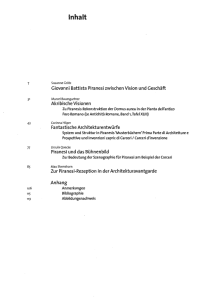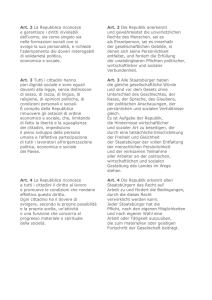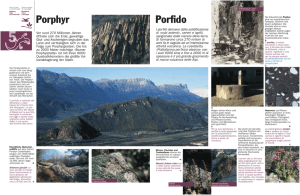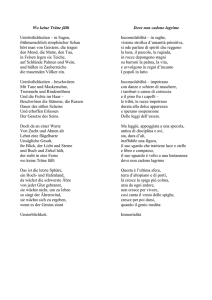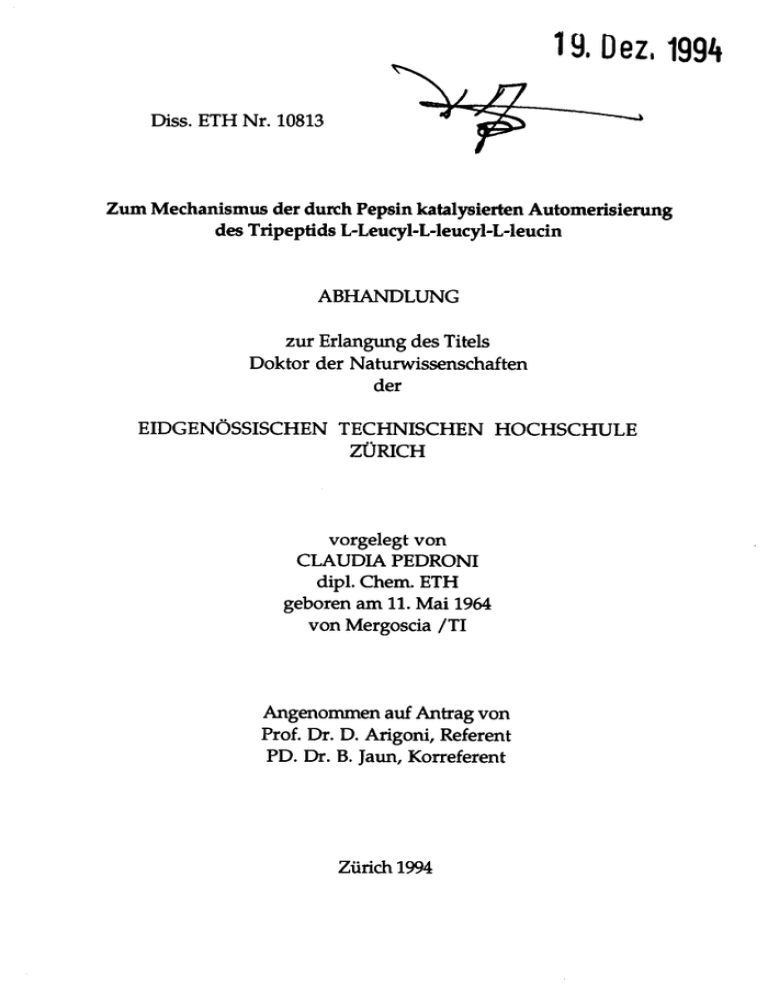
19. Dez, 1994
Diss. ETH Nr. 10813
Zum Mechanismus der durch
des
Pepsin katalysierten Automerisierung
Tripeptids L-Leucyl-L-leucyl-L-leucin
ABHANDLUNG
zur
Erlangung des Titels
Doktor der Naturwissenschaften
der
EIDGENÖSSISCHEN TECHNISCHEN HOCHSCHULE
ZÜRICH
vorgelegt von
CLAUDIA PEDRONI
dipl. Chem. ETH
geboren am 11. Mai 1964
von Mergoscia /TI
Angenommen auf Antrag von
Prof. Dr. D.
PD. Dr. B.
Arigoni,
Referent
Jaun, Korreferent
Zürich 1994
12
Zusammenfassung
Ausgangspunkt der vorliegenden Arbeit war die Beobachtung von
Tedford5, wonach die Umsetzung einer regiospezifisch mit 13(1markierten Probe von Leu-Leu-Leu mit dem Enzym Pepsin eine
Automerisierungsreaktion auslöst, die einer Zufallsverteilung
ursprünglichen Markierungsmusters entgegenstrebt.
des
Spätere Arbeiten von Labaudiniere80 bestätigten diesen Befund.
Die massenspektroskopisch vorgenommene Verfolgung der Zeitab¬
hängigkeit dieser Automerisierungsreaktion lieferte Resultate, wel¬
che
von
dahingehend interpretiert wurden,
Leu-Leu-Leu nach zwei
im nachstehenden Schema als
Weg a
C-A-B
A-B-C
dass die
Automerisierung
parallelen
Mechanismen abläuft, die
und ß festgehalten werden.
B-C-A
A-B-C
Geijsen82 das Substrat Leu13'18-Leu-Leu
zeigte NMR-spektroskopisch, dass dessen Umsetzung mit
Pepsin Tripeptidspezies lieferte, deren mittlere und C-terminale
Im Anschluss daran stellte
her und
Aminosäuren sowohl 13C- als auch 18Omarkiert
Im Lichte des
waren.
obigen Automerisierungsschemas
musste dieser
Befund als Beweis für das Auftreten eines kovalent
gebundenen
Zwischenproduktes im Laufe der pepsinkatalysierten Reaktion
gedeutet werden. Die Bedeutung dieses Resultates hängt kritisch
von der Gültigkeit des angegebenen Schemas ab. Es schien deshalb
angebracht, das Schema für die beobachtete Automerisierung einer
unabhängigen Prüfung zu unterziehen.
Im
Bestreben einen
unabhängigen, NMR-spektroskopischen
Automerisierungsreaktion zu
Nachweis für das Fortschreiten der
entwickeln, wurden Bedingungen ausgearbeitet, die
es
erlauben,
ursprünglichen kinetischen Parameter, eine
Beibehaltung
bei geringerer
des
Automerisierungsvorganges
Bevorzugung
der
unter
Enzymkonzentration
Zur
Untersuchung
Peptidbindungen
zu
der
erreichen.
Regiospezifität von Bruch und Bildung von
Automerisierungsreaktion wur-
im Laufe dieser
13
strategischen Stellungen mit 13C und 15N
Tripeptids Leu-Leu-Leu hergestellt und mit
Die
erhaltenen Resultate widersprechen dem
Pepsin umgesetzt.
von Labaudiniere aufgestellten Schema und führen zu einer neuen
Interpretation der Automerisierungsreaktion, die nachstehend
den sechs
spezifisch,
in
markierte Proben des
schematisch veranschaulicht ist.
a-Reaktion:
2A-B-C
AT)C:
^
°S>A
/L
t0u
C
2C-A-B
-*^A
B
ß-Reaktion:
B^>A
2B-C-A *
Resultate
^—s
n
2A-B-C
A^B
Diese
D
\V.
A
-*S,B
C
belegen zudem, dass die Spezies zweiter
gebildet werden als auf Grund der Gesetz¬
Generation schneller
mässigkeit einer zufälligen Verteilung zu erwarten wäre. Daraus
folgt zwingend, dass die automerisierten Substratmoleküle nach
dem ersten turnover zum Teil in der katalytischen Stelle verbleiben
und mit
unprozessierten Substratmolekülen
geschilderte
Dieses
Art und Weise in
aus
Wechselwirkung
der
Schema erlaubt aber nicht mehr, die
als bindenden Hinweis für die kovalente
neue
Lösung auf die
treten.
Ergebnisse von
Wirkungsweise
Geijsen
des Pepsins zu interpretieren, denn auch ein nach einer
allgemeinen Säure-Basen Katalyse wirkender Mechanismus würde
mit diesen Ergebnissen im Einklang stehen.
Um eine
Unterscheidung
zwischen den zwei Reaktionsmodi
herbeizuführen, wurde die trimarkierte
hergestellt
und mit
Pepsin umgesetzt.
Spezies Leu13-Leu-Leu18'18
Die in den Zeitabständen
vorgenommene massenspektroskopische Bestimmung
topenzusammensetzung des Reaktionsgemisches
überraschend eine zunehmende Abnahme der
das
Auswaschen
der
180-Markierung
der Iso¬
zeigte
lsO-Markierung.
rascher
als
Da
die
Automerisierung erfolgte, war der Nachweis der kritischen Spezies
verunmöglicht, und damit die angestrebte Aufklärung der
katalytischen Wirkungsweise von Pepsin einmal mehr verhindert.
14
Summary
The
for this
starting point
project
was
Tedford's5 Observation that
regiospecifically 13C-labelled specimen of the
with pepsin causes an automerisation
Leu-Leu-Leu
tripeptide
reaction which eventually results in a random distribution of the
original label.
treatment of
In later
a
work, Labaudiniere80 attempted
to follow the kinetics of the
automerisation process by mass spectrometric techniques; the
results were interpreted as being the consequence of the Operation
of two
parallel pathways
following diagram:
oc
and
ß,
which
A-C-B;
described in the
B-A-C
X
V
a
C-A-B
A-B-C
are
B-C-A
A-B-C
Subsequently, Geijsen82 synthesized a doubly labelled Substrate
Leu13,18-Leu-Leu and showed by NMR-spectroscopy that its
transformation by pepsin produces automerised species in which
the middle as well as the carboxyterminal unit still carry the 13C
and the ISO label.
On the basis of the Labaudiniere scheme this result
demonstration that
pepsin operates by
a
can
be taken
as a
mechanism which involves
covalently bound intermediate. Since the signifiproof depends critically on the validity of the
underlying automerisation model, it was feit mandatory to submit
this model to an independent experimental verification.
formation of
cance
First,
the
a
of this
new
experimental
automerisation
conditions
reaction
to
were
be
worked out which allow
carried
out
with
concentrated enzyme Solution and this in turn made it
follow the process by NMR techniques.
In order to determine the
of
peptide
bonds
during
regiospecifity
of
breaking
a
less
possible
to
and formation
the automerisation reaction it
was
next
synthesize specimens of the Substrate labelled
necessary
regiospecifically with i3C and i5N in Strategie positions. The results
to
15
obtained upon incubation of six such Substrates with
in accord with the
pepsin
are not
Labaudiniere
scheine; rather, they
original
suggest for the automerisation reaction the parallel Operation of
the two schemes indicated below:
Reaction
oc:
B
2A-B-C ~+—f.
Reaction
I )
-»...»
C^*^A
^BT
I
II
C
S.k
) I
.»...»
2C-A-B
B
ß:
-*-.-*.
2 B-C-A
In
'
addition, the
new
I
)
-f.-*.
II )
|
-*—«> 2 A-B-C
results also demonstrate that the second gene-
produced faster than expected on Statistical
ground; this implies that after the first turnover some of the automerised molecules do not leave the catalytic Site but interact by a
similar scheme with molecules from the original starting material.
ration
species
are
Within the framework of the
model the results of
Geijsen's
proof for a covalent mode
of action of pepsin, since they are equally well explained by a
mechanism involving general acid-base catalysis.
investigation
can no
longer
new
be taken
as
final attempt to discriminate between the two possible
mechanisms, a specimen of Leu13-Leu-Leu18'18 was synthesized and
In
a
sübmitted to the automerisation reaction since the
the alternative mechanism,
predicts
labelled with both 13C and lsO in its terminal
Unfortunately, analysis
covalent, but
the formation of
of the reaction mixture obtained after
different reaction times showed that the 180 label of the
material decrease
continually
at
of the automerisation reaction.
critical
species
a
rate which is
starting
faster than the
one
failure to detect the
Accordingly,
unequivocal conclusions to be drawn
mechanistic basis for the catalytic action of
does not allow
and the problem of the
pepsin remains veiled.
not
product
carboxylgroup.
a
16
Compendio
Questo lavoro trae spunto dalle osservazioni di Tedford5, secondo
cui, esponendo prolungatamente all'azione della pepsina il
tripeptide Leu-Leu-Leu marcato regiospecificamente con 13C, il
marchio
originale
subisce
una
distribuzione statistica.
Successivi lavori di Labaudiniere80 confermano
questo fatto.
L'osservazione del processo di automerizzazione in funzione del
tempo tramite spettroscopia di massa ha fornito risultati la cui
interpretazione
ha
portato all'elaborazione di
secondo il
principio
quäle
parallele a e ß indicate qui sotto
A-B-C
Piü tardi
Geijsen82
schema di
.
C-A-B
Leu13'18-Leu-Leu
uno
l'automerizzazione awiene per due vie
B-C-A
ha sintetizzato il sostrato
A-B-C
doppiamente
marcato
ha dimostrato per spettroscopia NMR che
l'automerizzazione produce tripeptidi marcati doppiamente con
13C
e
e
lsO sia sull'unitä centrale che
su
quella carbossiterminale.
Nell'ambito dello schema di Labaudiniere questo risultato va
interpretato come prova che il modo d'azione della pepsina mette
gioco intermedi legati sull'enzima in modo covalente. Poiche
l'interpretazione di questo risultato dipende eminentemente dalla
validitä dello Schema riportato, si e ritenuto opportuno sottoporre
tale schema ad una verifica indipendente.
in
Anzitutto
eseguire
piü
sono
State
elaborate condizioni che
la reazione di automerizzazione
diluite che, di riscontro, rendono
spettroscopia
NMR per
registrare
con
permettono
di
soluzioni d'enzima
possibile l'impiego
della
queste trasformazioni.
Per poter determinare la regiospecificitä della rottura e della
formazione di legami peptidici nel corso della reazione di
automerizzazione, si
e resa
necessaria la sintesi di sei
Leu-Leu-Leu marcati in modo
strategiche,
che
sono
poi
stati
tripeptidi
specifico con 13C e 15N in posizioni
sottoposti all'azione della pepsina. I
17
risultati cosi ottenuti
Labaudiniere
Reazione
sono
in disaccordo
suggeriscono
e
in
sua vece
2A-B-C
/B
J
I
^
»...»
J | .»
-«^A
I
II
C
CX^A
^B
B
B
'i
B
A
/~"\
A
«...».
)
|
S~\
A
*^B
Questi risultati
A
j [
II
.«...». 2A-B-C
^B
<r
er
mostrano
inoltre
che
le
specie
interagiscono
con
seconda
cui si deve dedurre che
riassetto alcune molecole automerizzate
centro catalitico ma
di
velocemente di quanto lo
generazione vengono prodotte piü
permettano le leggi della casualitä, da
primo
2C-A-B
ß:
2B-C-A -X
il
proposto da
seguente:
oc:
^B
Reazione
lo Schema
con
il modello
molecole
non
originali
dopo
lasciano
il
secondo lo
schema descritto.
Proiettati
nel
modello
nuovo
risultati
i
di
Geijsen
non
rappresentano piü la prova inequivocabile della catalisi covalente
esercitata dalla pepsina in quanto diventano compatibili anche con
una
catalisi acido-basica
Per tentare di trovare
meccanismi, il
sostrato
generale.
prova atta a differenziare tra i due
Leu13-Leu-Leu18'18 e stato sintetizzato e
una
sottoposto all'automerizzazione in quanto solo il meccanismo
covalente, ma non quello alternativo, e compatibile con la
formazione di
13c
e
del
miscuglio
un
prodotto
di automerizzazione
a
doppio
marchio
180 sul gruppo carbossilico. Inaspettatamente l'analisi MS
di reazione isolato
a
scadenze diverse mostra
chiaramente che la velocitä di scambio
supera nettamente
quella
dell'ossigeno
marcato
della reazione di automerizzazione. La
conseguente impossibilitä intrinseca di dimostrare la presenza della
specie richiesta vanifica gli sforzi intrapresi per elucidare il
principio d'azione del modo catalitico della pepsina.

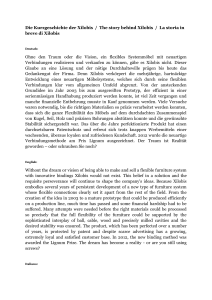
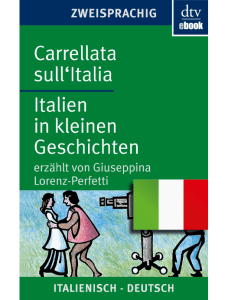
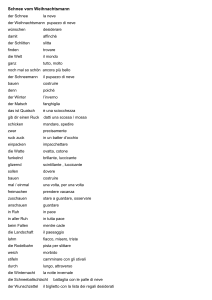
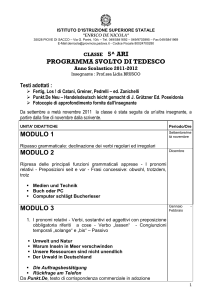
![Ricerca nr. 1 [MS WORD 395 KB]](http://s1.studylibit.com/store/data/000076742_1-2ede245e00e21c823e517529e1c3be46-300x300.png)

